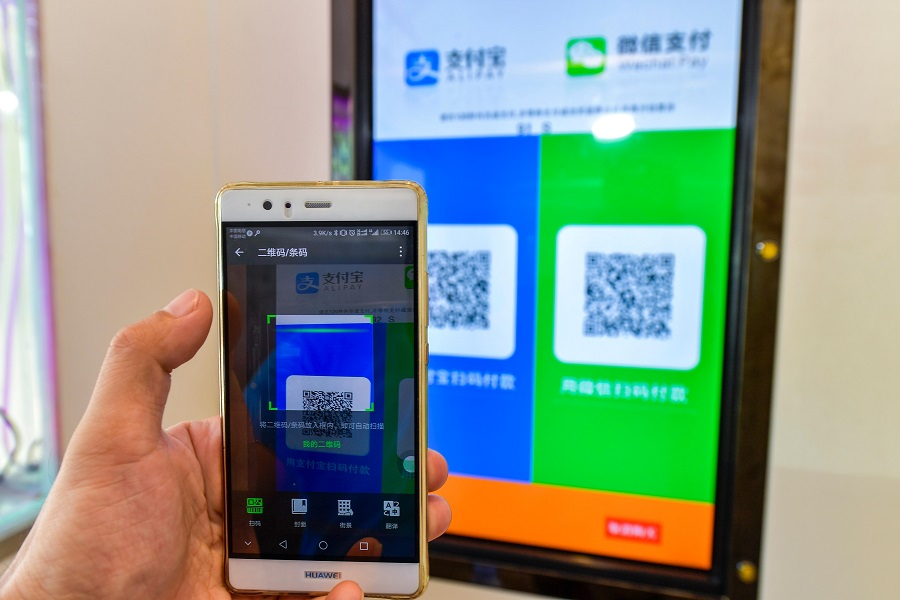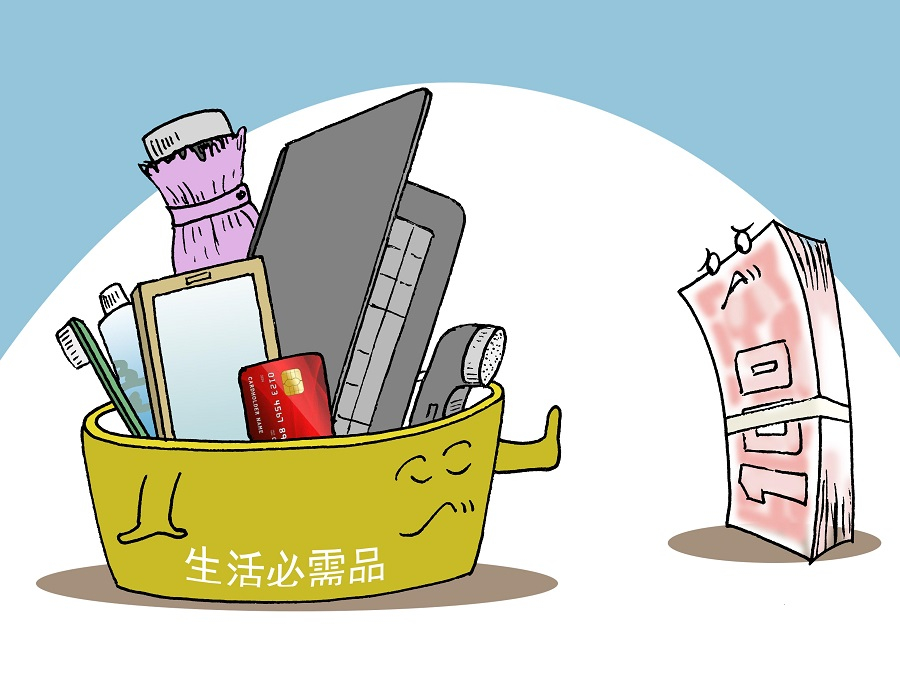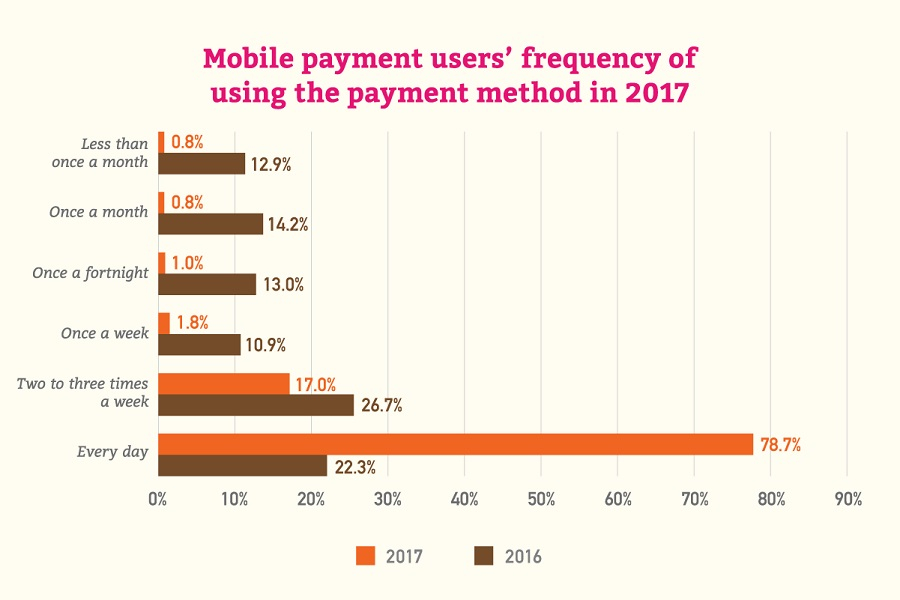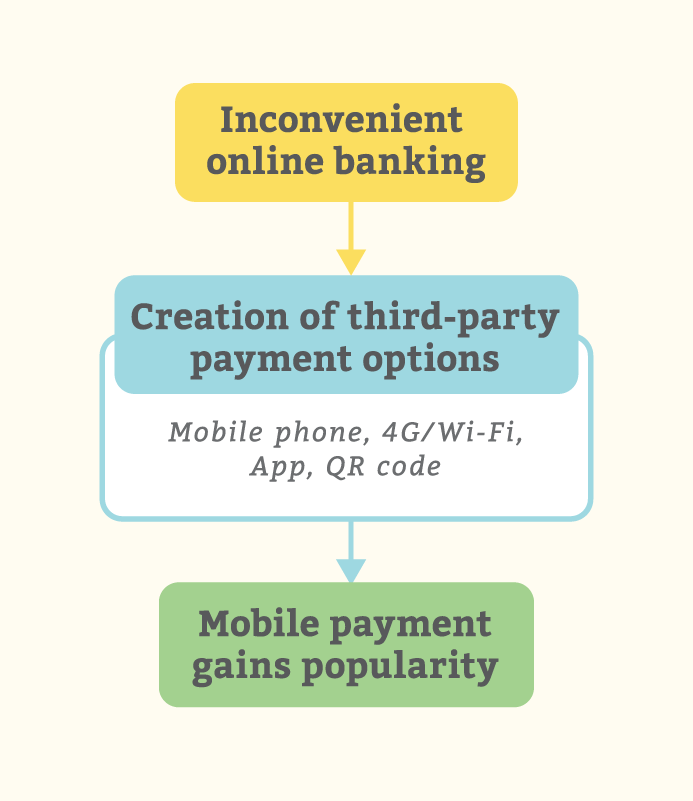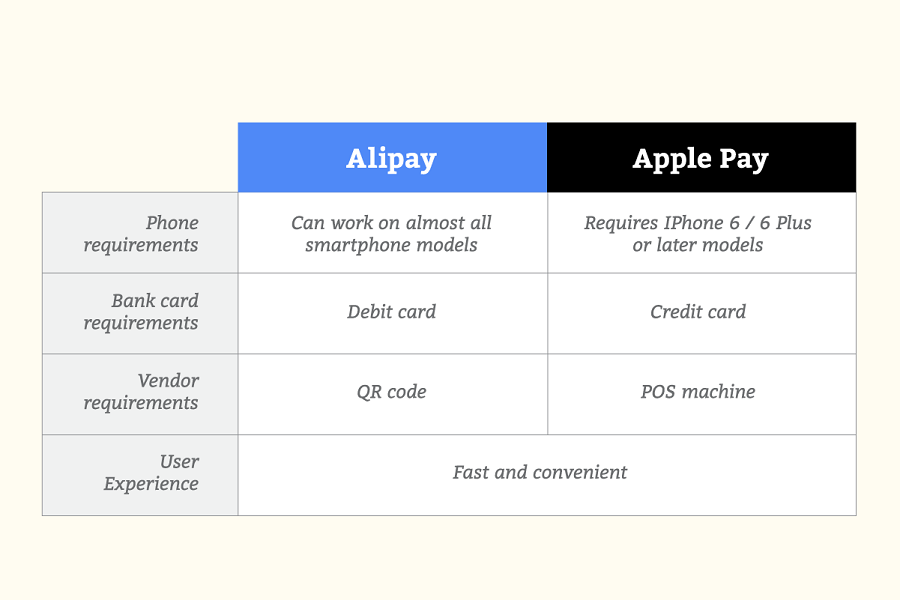Left home without your wallet? Thankfully, you may be cash-less, but far from helpless! China’s mobile payment technology is growing at an amazing pace and has permeated all aspects of life, evolving from third-party payment platforms in its early days to the QR code scanning payment systems now ubiquitous throughout the country. Thanks to mobile payment applications (apps) and the new services made possible by this new payment method, China has entered a “cash-free era,” and people are welcoming the extra convenience it offers.
Walk down any street in China, and you’ll notice almost all the shops sport a blue Alipay (支付寶) logo and/or a green Wechat Pay (微信支付) logo at their cashiers’ desk. Customers can pay simply by opening the respective mobile app and using its scanner to scan a plaque bearing the QR code at the cashier. Nowadays, the cash-free culture has taken off among young people, who would rather have simplicity than a wallet laden with cash and multiple credit cards. For them, mobile payment (also called phone payment) has hit the sweet spot.
According to statistics, there were a total of 560 million mobile payments in the nation in 2017, with annual mobile payment transactions reaching 157 trillion yuan and nearly 203 trillion yuan in 2016 and 2017 respectively. The rapid development of the mobile payment technology is life changing for its users - 78.7% of a survey’s respondents claimed they use it every day, mainly for “paying for living expenses,” “ticket purchasing” and “business travel-related spending.” Ease of operation, convenience and being able to do without cash or credit cards were the top reasons they cited for embracing mobile payment. One must wonder, how did mobile payment evolve from a novelty to a daily activity in people’s lives?
How did mobile payment take off?
Online payment became possible with the founding of UnionPay in 2002. However, connecting the financial network to the internet was a cumbersome process at that time. This prompted the rise of third-party payment services (platforms independent of banks and vendors), which acted as an intermediary to facilitate transactions. Another issue back then was trust, which was of particular concern to consumers engaging in online transactions. They had good cause for worrying: what if my online vendor is a scammer? Or, if my transaction gets terminated midway, what on earth am I supposed to do?
At that time, the online market Taobao (淘寶網) launched Alipay as a payment platform. After registering a user account and linking a debit/ credit card to Alipay, a user can accept payment, top up their digital wallets and transfer funds in a flash, with Alipay acting as the guarantor for both the buyer and seller of the transaction. This does away with the need for users to deal with cumbersome online banking processes. Over several years, the transaction volume of third-party internet payment grew at a rate of over 100% per year, and the total trading volume of online payment grew from 274.3 billion yuan in 2008 to 6,890 billion yuan in 2012, in part thanks to Alipay, which obtained its official licence to conduct payment services from the People’s Bank of China (中國人民銀行) in 2009.
From 2012 onwards, mobile payment began to gain attention in the mainstream as smartphone ownership, the 4G and Wi-Fi networks closed in on nationwide coverage. From then on, online payments that previously had to be conducted with a separate device could be processed with a mobile phone - an item most people have with them at all times and can be counted on for a fast internet connection, making e-payment a breeze. Alipay and Wechat Pay - a payment service provided by Wechat, the widely used mobile platform of Tencent Holdings (騰訊公司) - are now the most popular mobile payment methods.
The adoption of the QR code technology is also crucial, for, unlike traditional POS machines, vendors just need to print a QR code on a piece of paper and put it up on the wall. This provides a convenient way for them to receive payment and also cuts costs significantly. Considering many small street-side shops are low-capital businesses, one cannot reasonably expect them to be equipped with 1,000-yuan POS machines, especially when customers won’t even bother to dig out their credit cards for small purchases. By simply putting up a printout of a QR code, they can have most of their transaction issues taken care of; why not go for it? And that is how the QR code payment system came to be adopted nationwide.
Over many years of development and refinement, China’s mobile payment technology has become increasingly sophisticated, so much so that it may be the current leader. In February 2017, the UK’s Financial Times compared studies conducted by China and the United States on their respective mobile payment markets and concluded that the size of China’s mobile payment market in 2016 was 50 times that of the United States; in July 2017, Bloomberg News also published an article titled “China’s Cashless Revolution,” with the claim that China’s use of the QR code system for payment offers a useful model and standard that other countries could emulate.
Why are Alipay and Wechat Pay so popular?
In Hong Kong and foreign countries, while many shops offer mobile payment options like Apple Pay and Android Pay, the scale of adoption among the public is a far cry from the near-universal one seen in Mainland China. What’s the difference between these payment options and those used in the Mainland? Let’s use Alipay and Apple Pay for a simple comparison:
Although both offer a convenient way to pay with one’s mobile phone, Alipay can work on almost all smartphones as long as the user downloads the relevant app and registers an account. Apple Pay, on the other hand, is only compatible with iPhone 6/6 Plus or later models and Apple Watch. Also, Alipay allows users to link debit cards to their accounts in order to register, while Apple Pay requires users to have a credit card in order to register. In terms of devices required to process the transaction, vendors just need a printout of a QR code in order to receive payment via Alipay, while a POS machine is required to enable transactions with Apple Pay. We have created the following table based on the factors mentioned above:
Actually, in the comparison above, the second point is the most important: why does Alipay allow users to register with their debit cards? In China, the credit card culture is still immature and its average credit card ownership is less than 0.5 cards per capita. Average credit card ownership in Hong Kong is at 2.6 and its consumers, like their counterparts in Europe and the United States, are very familiar with using credit cards for purchases. Alipay, on the other hand, must work with the more diverse circumstances of its users. The convenience of using QR codes to accept payment also enables mobile payment (chiefly represented by Alipay and Wechat Pay) to better cater to the needs of more individuals and businesses.
Furthermore, payment is not all that Alipay and Wechat can do: their apps can also be used to facilitate timely transfer of funds, pay bills, repay loans and enable vendors to roll out new services made possible only by the apps, like takeout ordering and requesting rides, in effect touching every aspect of people’s daily lives.
So, is cash still your go-to payment option, or are you ready to enter the brave new world of mobile payment?
References:
China's Cashless Revolution Bloomberg News July 18, 2017
China Mobile Payments Dwarf Those in US as Fintech Booms, Research Shows Financial Times Feb 14, 2017
2017 China's Third-Party Payment Market Report(《2017年中國第三方移動支付行業研究報告》) iResearch Consulting Group(艾瑞諮詢) June 12, 2017
Mobile Payment User Survey Report 2017 (2017年移動支付用戶調研報告) the Payment and Clearing Association of China’s Mobile Payment and Network Payment Application Working Committee (中國支付清算協會移動支付和網絡支付應用工作委員會) Jan 2, 2018
The Payment Revolution: Third-Party Payment in the Internet Era (支付革命:互聯網時代的第三方支付) by Zhu Xiaoming (朱曉明), Ma Mei (馬梅), Liu Shengjun (劉勝軍), CITIC Press (中信出版社) 2014




